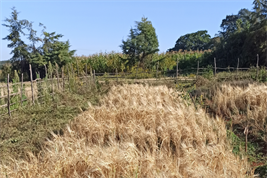11. October 2024
Yield increase of over 1000%:

A new study published in the journal Frontiers in Environmental Science shows promising results for the cultivation of barley in Kenya. The use of local sediment can significantly increase barley yields on acidic soils and significantly reduce the use of phosphorus fertilizers. The Leibniz Center for Agricultural Landscape Research (ZALF) led the project.
Scientists conducted an experiment in Eldoret, Kenya, in which two different local sediments of 1% and 3% weight were added to barley plots. The sediments used originate from the vicinity of Lake Baringo and Nakuru National Park in Kenya respectively, have not been used so far and can be easily used. The so-called Baringo sediment in the higher dose showed particularly impressive results: The pH value of the soil increased from 4.7 to 7.0, the phosphorus availability doubled and the aluminum availability, which is toxic to plants, decreased. This led to an increase in yield to 4.7 tons per hectare - an increase of over 1000%.
Small farmers in Kenya could benefit
The study is particularly important for smallholder farmers in East Africa, who often struggle with low yields due to soil acidification and a lack of fertilizer availability. "Our research shows that local solutions, such as the use of local sediments, can make a big difference in increasing yields and fertilizer use," explains Prof. Jörg Schaller, head of the study at ZALF.
Benefits for the environment and agriculture
The sediments enriched by volcanic deposits in Kenya are rich in silicon, which plays an important role in binding phosphorus in the soil and reducing aluminum toxicity. This property leads to healthier plants and better yields. The special feature: The use of phosphorus fertilizers can be reduced, which lowers costs for farmers and protects the environment at the same time.
The study emphasizes that this method could be used not only in Kenya, but also in other regions with similar soil problems. However, the results depend on the type of sediment used and the amount added.
The future of research and application
While the study shows promising initial results, further research is needed to test the potential of the process in other regions and assess the long-term effects on soils. The researchers plan to further investigate the long-term effects of sediment enrichment and extend its applicability to other crops.
Projektpartner:
-
Leibniz Center for Agricultural Landscape Research (ZALF)
-
ETH Zurich, Switzerland
-
University of Eldoret, Kenya
Funding information:
The research was funded by the Seeding the Future Foundation (US).
Further information:
To the original publication:
https://doi.org/10.3389/fenvs.2024.1458360
 Meldung als PDF
Meldung als PDF
Note on the text
This is an AI-generated summary of the original text: Scherwietes, E., Stein, M., Six, J., Bawen, T. K., & Schaller, J. (2024). Local sediment amendment can potentially increase barley yield and reduce the need for phosphorus fertilizer on acidic soils in Kenya. Frontiers in Environmental Science, 12, 1458360.
https://doi.org/10.3389/fenvs.2024.1458360 published Open Access.
The text has been carefully reviewed and revised in the light of the AI regulations at ZALF
